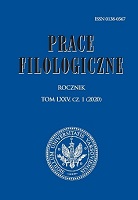Pojęcie heterografii ideograficznej w języku japońskim
The Notion of Ideographic Heterography in Japanese
Author(s): Grzegorz P. WaśniewskiSubject(s): Language studies, Semantics, Philology
Published by: Wydział Polonistyki Uniwersytetu Warszawskiego
Keywords: Japanese writing system; Sino-Japanese ideograms; variants of ideographic writing; homonimy; polysemy;
Summary/Abstract: Up till now, in the Japanese linguistics in use are many traditional grammatical terms applied in the description of national language which have no equivalents of a more general, universal nature allowing their use within theoretical linguistics which is accepted abroad. In particular, such openly relative terms are connected with the area of graphemics, where the structure, functions and scope of use of ideographic script are being presented still in a traditional way. One of such notions is the so-called dōkun-iji同訓異字, a term coined in the form of Sino-Japanese tetrad (four-character compound), which deserves a more universal analysis as an explanation of ideographic heterography of genuine Japanese words. This phenomenon is particularly connected not merely with heterography, but also with polysemy and homonymy of language units, belonging to its both semiotic planes, namely the substantially phonic plane and the substantially graphemic one. The exceptional situation of the Japanese language requires taking into consideration – in the description of its language structure – both planes. This leads to consequently bilateral apprehension of genuine Japanese words as a unity of ideographic (mixed with syllabography) and phonic representation of respective lexemes. Consequently, both homonymy and synonymy must be discussed in regard to both aforemen-tioned planes of linguistic structure. Unfortunately, in modern analyses of linguistics phenomena, the phonocentric way of interpretation clearly prevails. This fact would constitute a significant barrier in investigation of languages such as Japanese.
Journal: Prace Filologiczne
- Issue Year: 75/2020
- Issue No: 2
- Page Range: 319-341
- Page Count: 23
- Language: Polish

